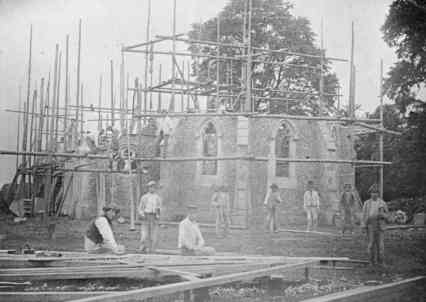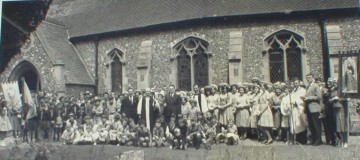
|
Arborfield
|
|
Churches
Related sites:
Monuments in new churchyard, as recorded in 1929 New church under construction, from the east New church under construction, from the west Inscriptions in the New Church, as recorded in 1929
|
Under Construction Two glass plates survive that show the building under construction in 1862-3. Click on the images to see them in more detail.
Interior The inside of the church has not changed too much over the years, as these photos from the 1940's and 1994 show. Click on the pictures for more detail: 

The Walker Organ was originally sited in the Chancel next to the Vestry, and so it would have been obscured in the earlier photo. It was later moved to the back of the church, under the bell tower. It's not certain how any of the bells can be removed for any reason. Another consequence of re-siting the Organ is that various wall plaques are now partially hidden. The Standen Tomb and wooden font at the back of the church were moved from the old church in the 1930's, along with other wall plaques. The altar rail was also taken from the old church and installed in the early 1950's. The 'Hargreaves Pews' in the Chancel commemorate the family that funded the new building.
The PCC from 1935 to 1954 The generation from the mid-1930's to the mid-1950's saw some tremendous changes in their way of life - and the Parochial Church Council (PCC) was no different. The Minute Book that covers this period offers some fascinating insights.
Centenary Sunday - 23rd June 1963
Also, the Church published a History document which described the interior of the church and its bells. The text is reproduced below:
St. BARTHOLOMEW'S CHURCH, ARBORFIELD The Present Church
AT a Vestry Meeting held at the old Church on Easter Monday, April 21st,
1862, of which the following is an extract, steps were taken to initiate
the building of the present church. Mr. Wells and Mr. Englefield were appointed Churchwardens. It was agreed that this Vestry offer their grateful thanks to Colonel Brown for his munificent offer to build a Church for the Parish of Arborfield, with better accommodation for the poorer Parishioners and on a more convenient site and that this Vestry approve the change of site.
J. WARREN HAYES, Rector. RICHARD WELLS The land for the new church was given by Mrs. John Hargreaves, of Arborfield Hall, who was related to Col. Brown, later Sir William Brown, Bart. The foundation stone was laid in August 1862, the architect was James Allanson Picton, later sir James Picton who died in 1889 (Mrs. J. R. Knowles of Carters Hill is a descendant). Picton was also an antiquary, editor of The Watchman's Lantern, wrote Memorials of Liverpool, two volumes in 1873, originated the Liverpool Public Library and Museum, where there is a bust of him by McBride, and was knighted in 1881. The church was built by Hughes of Liverpool at a cost of over £4,000, to which sum Sir William Brown, Bart, of Liverpool was the principal contributor. It is in Early English style with walls of flint and stone dressings, and the 100 feet high tower is of three stages, with a stone octagonal spire, and a peal of six bells. It has an apsidal chancel, with a north vestry, a nave with pews for a congregation of 250, a west tower and a south porch. The churchyard contains several large elm trees. The church is entered on the south side by a lych gate. The roof is supported by queen post wooden trusses. St. Bartholomew's was dedicated by Samuel Wilberforce, Bishop of Oxford, on June 19th, 1863. Bells Of the peal of six bells, five came from the old church. They are as follows:— 1st—the treble (the smallest) weighs 3 cwt. 2qrs. 31bs., is inscribed with a trefoil, lion's head and a crown, and is one of the oldest known bells made in the Wokingham Foundry in the 14th century. 2nd—weighs 4 cwt. 2qrs. 61bs., and is inscribed "John Waterman, Rector, Robert Grace, Thomas Cowdry, churchwardens," and "R. Catlin. Fecit. 1743". 3rd—weighs 5cwt. 3qrs, 21bs., and is inscribed "John Webb, Matthew Milam, churchwardens", and dated 1653, 4th—weighs 6cwt. Oqrs. 121bs., and is inscribed "Pryase ye the Lorde" with a coin between the beginning and the end of the sentence; below this are the initials "J. C." for Joseph Carter, with the date 1589 and between the initials is a shield on which is a bell and the letters "R.M."—probably a thanksgiving gift celebrating the defeat of the Spanish Armada, 1588. 5th—weighs 8cwt. 2qrs. 231bs., and is inscribed "Love God, 1639". 6th—the tenor, weighs 11cwt. 2qrs. 241bs., and was given by John Simonds of Newlands in 1862. It was cast by John Warner and Sons from old gun metal. The bells were re-hung in 1911 by F. Webb of Kidlington in a new iron frame with pits for eight, at a cost of £145. Unfortunately the canons, an old method of attaching the bells to the headstock (or axle) were removed from all the bells at the time. The Wokingham bell foundry was a renowned and important one, but no name has been discovered of an owner earlier than the middle of the fifteenth century. There was, however, a bell cast from it in 1383. Roger Landon was the earliest known Wokingham founder. The foundry had a branch in Reading and John White, founder, migrated there, but the Wokingham foundry was subsequently revived and was the home of several great bellfounders, the Knights, Carters, etc. (Reading later absorbed the business). Bryan Eldridge was making bells in Woking-ham in 1624, so the town took a leading part in the industry over a very long period. Interior of Church Passing now to the interior of the church, the Holy Table is of Queen Anne period and the chairs (sedilia), on each side of the apse, are of King Charles II period. The plate consists of two patens one inscribed "1600 A.D.", the other "Richardus Hayes hujus ecclesiae Rector, A.D. 1793", a chalice dated 1849 and a flagon dated 1886. There are two fonts, the one near the organ at the west end being the older. It has a lead bowl inscribed "Arborfield M.W. — R. S. Churchwardens, 1762" on the rim, in an octagonal wood base with an eight sided conical cover, also in wood, of the 13th century and came from the old church. The second font is near the pulpit, is of stone and dated 1863.
The stone pulpit is inscribed "Blessed are they that hear the Word of
God and keep it, 1863". "To the honour of God most High and to beautify the Church, John Water-man, Master of Arts, Rector, gave and dedicated this window decorated with these pictures, and all the Chancel ornaments at his own expense, in the year of salvation, 1744." The glass was made by John Rowell, plumber, of High Wycombe, and later of London Street, Reading, and was then considered of outstanding craftsmanship. John Waterman was Rector from 1739 to 1755. The next window on the south side of the Nave is in memory of William Vincent who died in 1904, and Sarah Jane, his wife, who died in 1916, and is inscribed "Draw out now and bear unto the Governor of the Feast". The window near the chancel, a double one, is in memory of Sir John Warren Hayes, M.A., Rector, 1839 to 1879, who died in 1896 aged 96. One part is inscribed "A sower went forth to sow" and the other part "The good Samaritan".
Behind the organ is a small window showing an angel and "Alleluia"
lettered at the base. On the south side of the Apse is a window in memory of Lt. Col. Joseph Towgood, who died in 1858, and his son, Frederick William Towgood, who died in 1894. One has the inscription "I am the Good Shepherd" and the other "Jesu mercy". Inset in the stone at the base is a brass in the form of a cross and engraved "And now Lord what is my hope, truly my hope is even in Thee" on the four arms. Behind the Holy Table are three windows, the central one showing the Resurrection and inscribed "Christ to the Glory of God" and, on each side windows showing angels, one window to the memory of Stuart Hamilton Rickman, Captain R.N. born 1843, died 1913, and the other to the memory of Ellen Anne Simonds, born 1846, died 1896. On the wall behind the Holy Table are four painted panels, one inscribed with the Apostles' Creed, two with the Ten Commandments and the Lord's Prayer. On the south wall of the Chancel are two mural tablets, one is "In memory of Sir William Brown, Bart, by whom with the aid of Rev. Sir John Hayes, Bart, this church was built, born 1799, died 1896, also of Sarah, wife of Thomas Har-greaves, of Arborfield Hall, born 1833, died 1918". The other is in memory of "The Family of Simonds, who have lived in Arborfield and Newland for 600 years. The Sanctuary rails were brought from the old church and used again from 1948", followed by names of six descendants, the last one being Edward Guy Simonds, R.A.F. killed in action, 1943. On the north wall of the Chancel is a tablet "To the memory of Ellen, who died 1849, wife of Rev. John Warren Hayes, Rector". On the wall above the east windows is painted the inscription "TAKE, EAT THIS IS MY BODY, WHICH IS BROKEN FOR YOU, THIS DO IN REMEMBRANCE OF ME". Over the Chancel arch is painted the inscription "O COME LET US WORSHIP AND FALL DOWN AND KNEEL BEFORE THE LORD OUR MAKER, FOR HE IS THE LORD OUR GOD". Over the west arch in the Nave by the organ, overlooking the font, is painted the inscription "SUFFER LITTLE CHILDREN TO COME UNTO ME AND FORBID THEM NOT". Above each of the nine windows of the Nave are texts from the Bible. The Church registers previous to 1812 are:—Mixed entries, 1707 to 1739, and Mixed entries 1739 to 1812, and Marriages only from 1756 to 1812. The organ was made by J. W. Walker, London, in 1863 and moved from the chancel to the west of the church sometime later.
At the west end is the tomb of William Standen removed from the old
church in 1939. Above the Standen tomb is a mural tablet to Edward
Standen, the last of the Standens on the male side who died in 1730.
Adjacent to the south door are mural tablets to the men who fell in the
Wars of 1914-18 and 1939/45. Also there are brass tablets on the south
wall to Thomas Howard, who died in 1643, and another to Henry Hodgkinson,
Rector, who died in 1839. - taken from the Church History booklet dated 1963.
|
||
|
Any Feedback or comments on this website? Please e-mail the webmaster |


 The
Parish celebrated its Centenary in June 1963, and a group photograph was
taken in front of it, as seen here. If you want to see close-up views of
the people, click on the picture.
The
Parish celebrated its Centenary in June 1963, and a group photograph was
taken in front of it, as seen here. If you want to see close-up views of
the people, click on the picture.